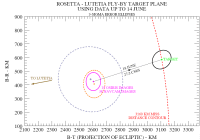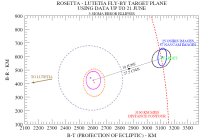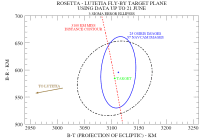No. 138 - Trajectory correction manoeuvre
On 11 June, the attitude and orbit control system (AOCS) and the telemetry, tracking and commanding (TT&C) subsystem were configured for the Lutetia flyby.
On 14 June, a NASA ground station in Madrid (DSS-63; 70m dish) was used to rehearse the operations planned for the Lutetia flyby. The test included a telemetry bit rate change during the pass and the data acquisition in X- and S-band for the RSI experiment. The test was successful.
On 18 June a TCM was successfully performed to adjust Rosetta's trajectory towards asteroid Lutetia. The manoeuvre was executed around 06:28 UT and had a nominal magnitude of 27.5 cm/s.
During the reporting period, mission operations have been conducted with support of the ESA New Norcia (NNO) ground station. Additional tracking passes were performed with the NASA DSN ground stations in Goldstone (DSS-24 and -25), Canberra (DSS-34 and -45) and Madrid (DSS-54, -55, -63 and -65) as part of the navigation campaign for asteroid Lutetia:
| DOY | Date | Pass | Main Activity |
| 156 | 05/06/10 | DSS-55 2293 | Monitoring |
| 157 | 06/06/10 | DSS-65 2294 | Monitoring |
| 158 | 07/06/10 |
NNO 2294 |
Optical navigation slot 2 Monitoring |
| 159 | 08/06/10 | DSS-25 2295 | Monitoring |
| 160 | 09/06/10 | NNO 2296 DSS-54 2297 |
Optical navigation slot 3 Monitoring |
| 161 | 10/06/10 | DSS-45 2297 | Monitoring |
| 162 | 11/06/10 | NNO 2298 |
AOCS and TT&C configuration for flyby |
| 164 | 13/06/10 | DSS-54 2301 | Monitoring |
| 165 | 14/06/10 | NNO 2301 DSS-63 2302 |
Optical navigation slot 4 Flyby operations rehearsal |
| 166 | 15/06/10 | DSS-24 2302 | Monitoring |
| 167 | 16/06/10 | NNO 2303 | Optical navigation slot 5 |
| 168 | 17/06/10 | DSS-54 2305 | Monitoring |
| 169 | 18/06/10 | NNO 2305 | TCM, 3 weeks before closest approach |
| 170 | 19/06/10 | DSS-45 2306 DSS-24 2307 |
Monitoring Monitoring |
| 171 | 20/06/10 | DSS-34 2307 DSS 2308 |
Monitoring Monitoring |
|
DOY = Day of year | |||
At the end of the reporting period (DOY 171) Rosetta was at 394.84 million km from Earth (2.63 AU) and the one-way signal travel time was 1317 seconds (21 minutes and 57 seconds). The distance to the Sun was 383.55 million km (2.55 AU). Rosetta was at 26 million kilometres from asteroid Lutetia.
Optical Navigation Campaign
Rosetta will fly by asteroid (21) Lutetia on 10 July 2010 at a distance of less than 3200 km from the asteroid. In addition to the spacecraft tracking and usage of radiometric data for navigation purposes, in the final weeks leading up to this flyby Rosetta's on-board cameras visually track the asteroid in an optical navigation campaign. The optical observations are fed into the orbit determination process to refine Lutetia's predicted location and to optimise Rosetta's trajectory for the upcoming flyby.
The three cameras that are used for the optical observations are Rosetta's two navigation cameras (NAVCAM A and B) and the narrow angle camera (NAC) of the OSIRIS instrument. NAVCAM A and B are permanently ON already since 30 May (DoY 150). On 18 June (DOY 169) the CCD temperature of both navigation cameras was lowered from -25°C to -30°C to reduce the number of warm pixels. OSIRIS-NAC is ON since 2 June (DOY 153).
A series of observation slots have been allocated for the optical navigation campaign and four of these slots were completed in this reporting period on 7, 9, 14 and 16 June.
Navigation status
Information on Rosetta's current trajectory comes from telemetry transmitted by Rosetta and from data received from the ground stations that are tracking the spacecraft regularly. From this data the spacecraft projected trajectory is calculated up to the time of the flyby. The orbit of asteroid Lutetia and its predicted position on 10 July are derived from a long record of ground-based astrometric observations of the asteroid, plus the new input from Rosetta's optical navigation campaign. Below are several plots showing the predicted situation in the target plane of the Rosetta - Lutetia flyby. They show the progressively more accurate predictions based on data up to 7 June, 14 June and 21 June.
The target point for Rosetta in these plots is indicated in green. The TCM on 18 June has moved the point of Rosetta's projected trajectory in the target plane very close to the target.
The red curve in the above plots corresponds to a miss distance of 3160 km from Lutetia. This is the minimum allowed flyby distance for Rosetta. If the spacecraft would pass closer to Lutetia the asteroid would fill up the entire field of view of Rosetta's cameras during closest approach. This would impact the spacecraft's attitude control (the images guide the attitude control system) and also the scientific observations which are prepared to be performed from within a pre-set distance from the asteroid.
Spacecraft
Payload
ALICE
The instrument is currently OFF.
CONSERT
The instrument is currently OFF.
COSIMA
The instrument is currently OFF.
GIADA
The instrument is currently OFF.
MIDAS
The instrument is currently OFF.
MIRO
The instrument is currently OFF.
OSIRIS
Since DOY 153 the instrument is ON and regularly takes images of asteroid Lutetia as part of the optical navigation campaign.
ROSINA
The instrument is currently OFF.
RPC
The instrument is currently OFF.
RSI
The ultra-stable oscillator (USO) is ON/muted since DOY 032/2010.
VIRTIS
The instrument is currently OFF.
LANDER Philae
The instrument is currently OFF.
SREM
The instrument is ON with standard settings since DOY 032/2010.
Future Milestones
The two navigation cameras and OSIRIS narrow angle camera on-board Rosetta continue to take images of the asteroid (21) Lutetia twice a week. Later in the optical navigation campaign images will be taken daily. Four more slots are available for a trajectory control manoeuvre should they be required. The TCM slots are at 1 week, 3 days, 40 hours, and 12 hours before closest approach.
The closest approach to the asteroid is currently expected on 10 July 2010 at 15:44:56 UTC.
---
Legal disclaimer
This report is based on the ESOC mission operations report, WOR #138. Please see the copyright section of the legal disclaimer (bottom of this page) for terms of use.






